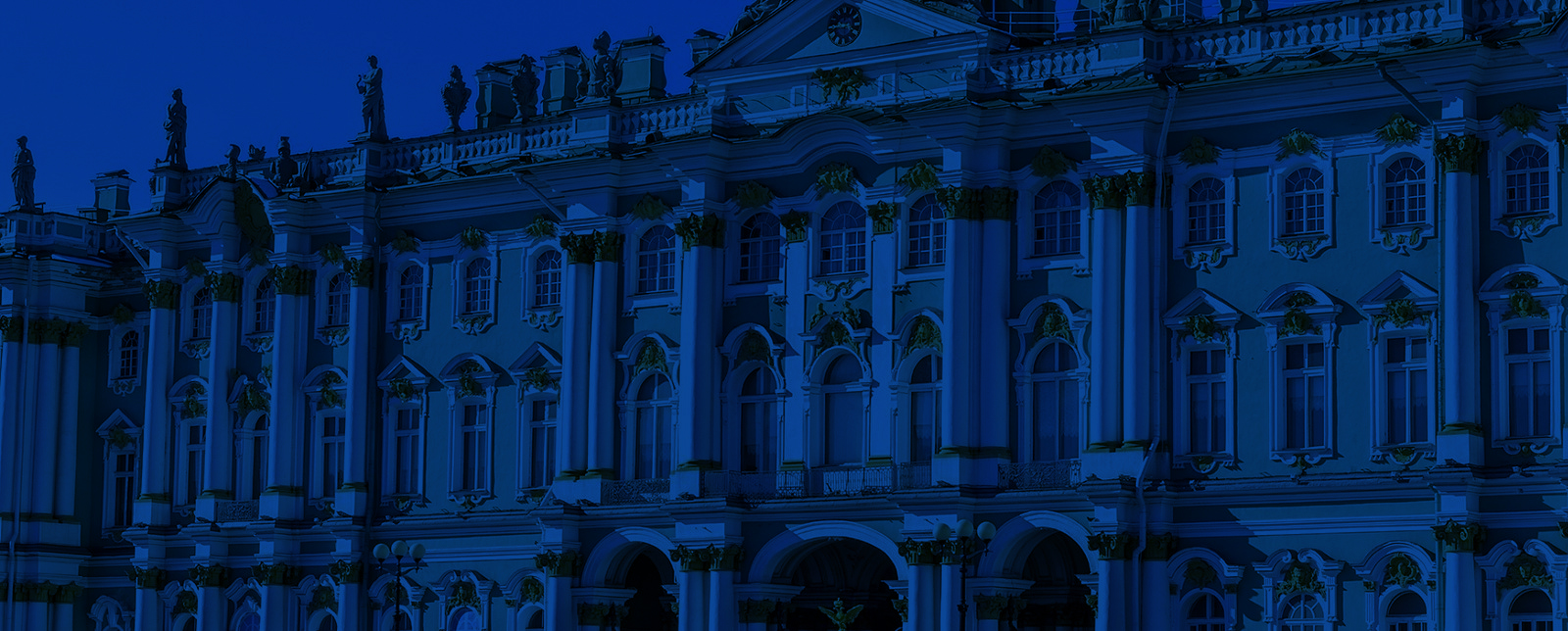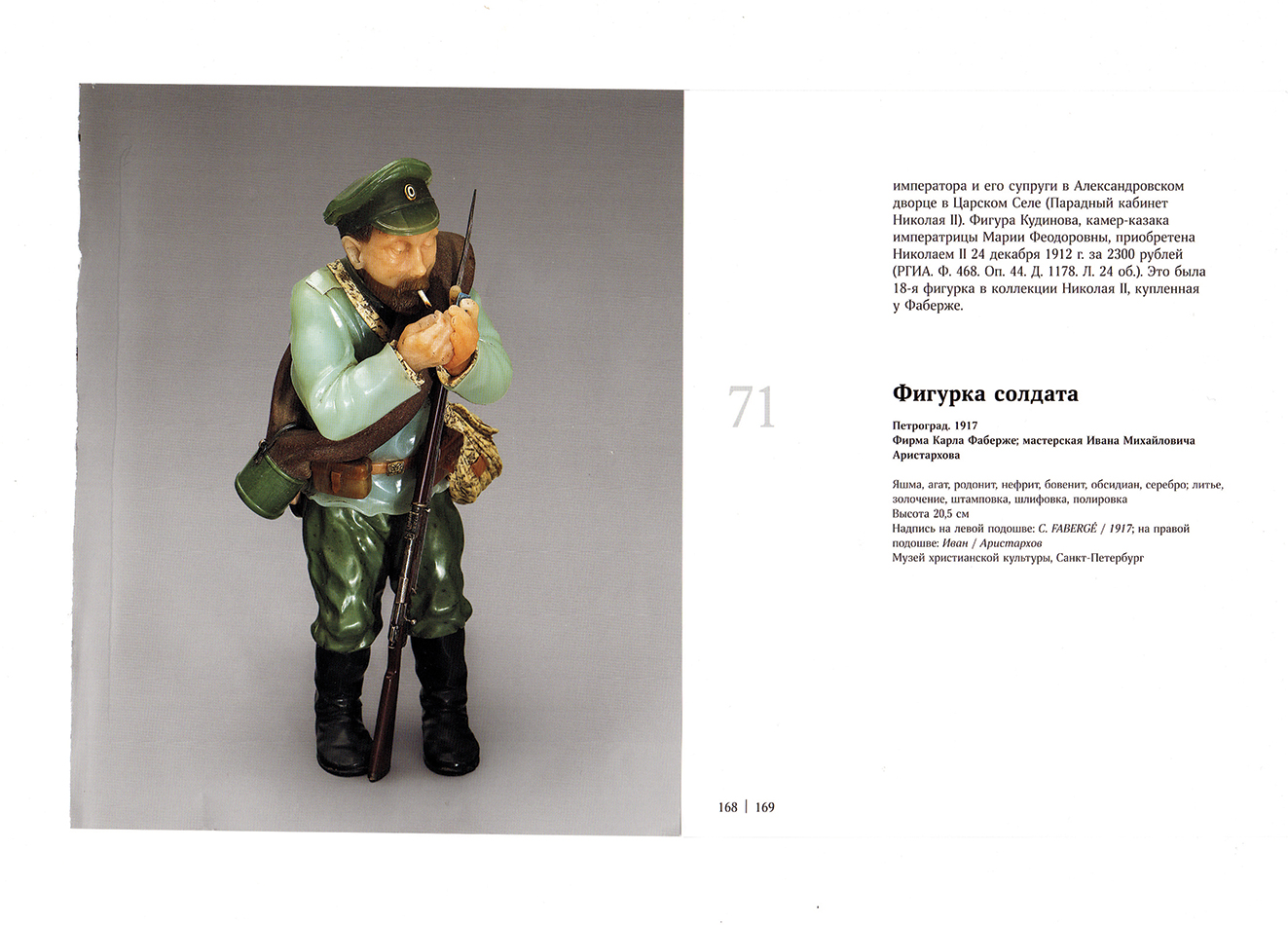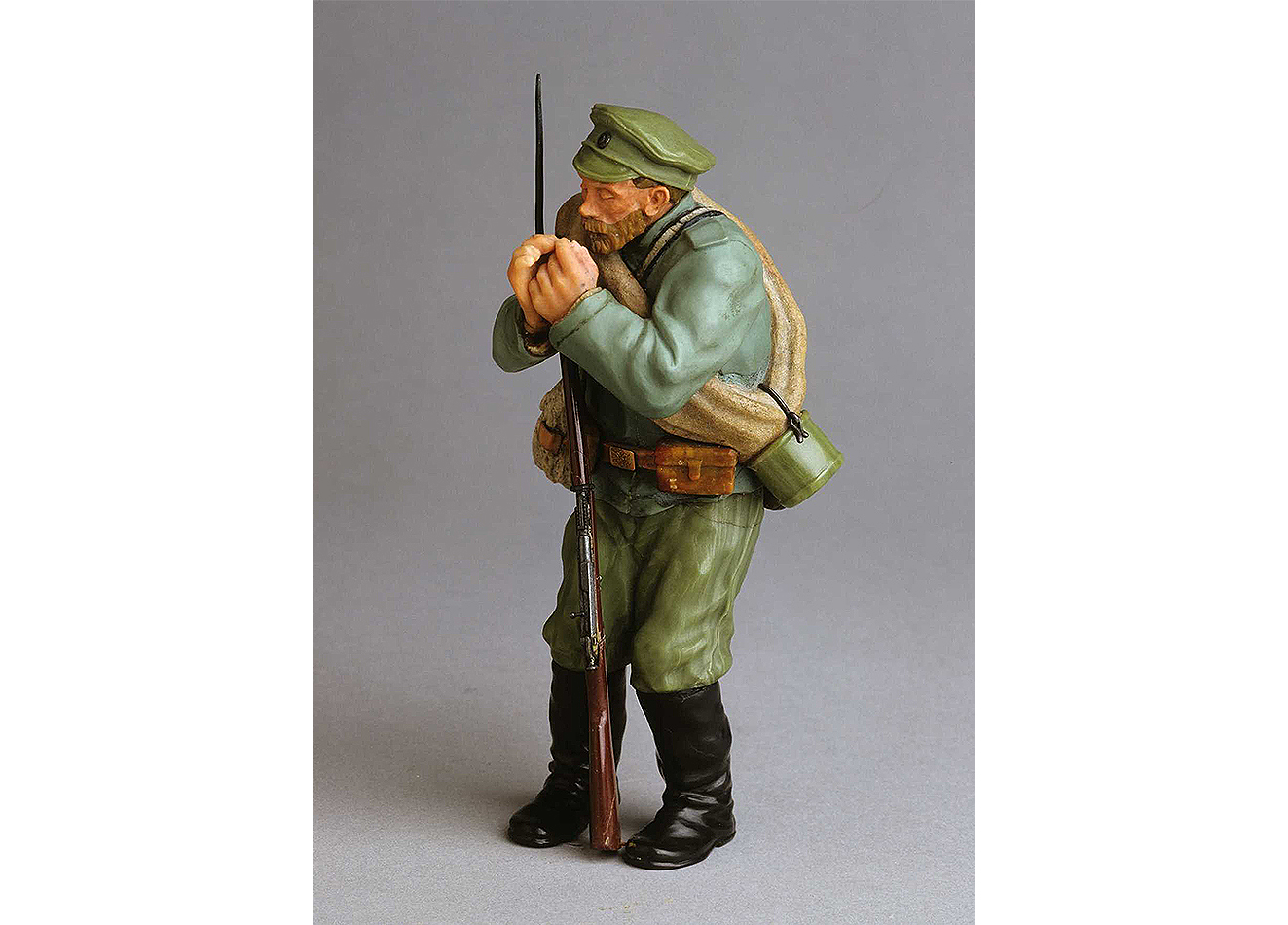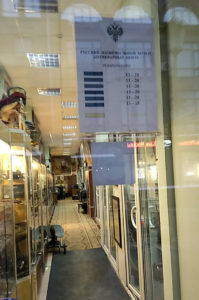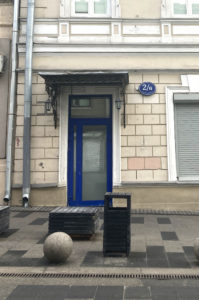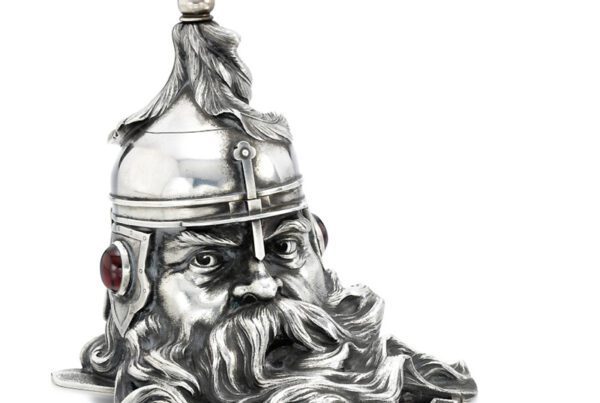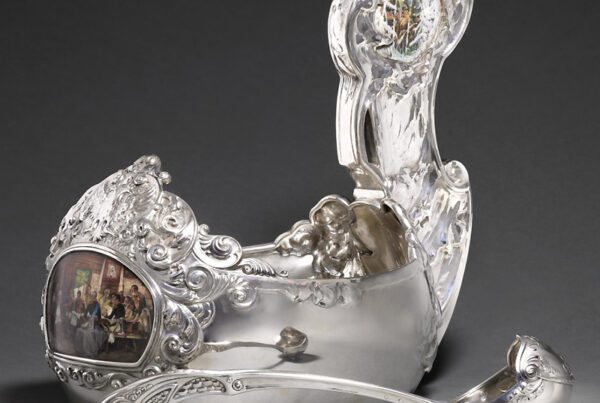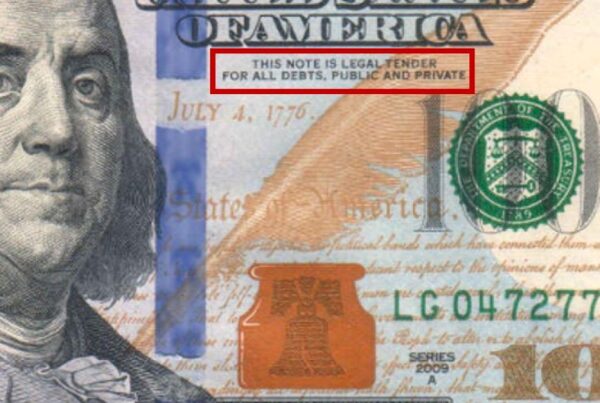The Hermitage Fauxbergé Show is Over But the Stench of Scandal Lingers On
The Ivanov Exhibition of Fake Fabergé in the Hermitage, officially styled Fabergé – Jeweller to the Imperial Court, has drawn to a triumphant conclusion.
At the official opening of the exhibition back in November, Hermitage Director Mikhail Piotrovsky made some bizarre comments about how some of the items on display might raise questions.
Why should that be, we wondered? What were we going to see? What was the purpose of the exhibition? And why would there be questions about its contents during the exhibition, rather than before?

‘Fabergé – Jeweller to the Imperial Court’ exhibition vitrine: fake figure of soldier in the center from the Museum of Christian Culture, St Petersburg (formerly from the Fabergé Museum in Baden-Baden), on the right original Fabergé figure of Chamber Cossacks A.A.Kudinov, Pavlovsk State Museum, St Petersburg
The exhibition was staged in the Armorial Hall, one of the swankiest in the Hermitage, yet the items were displayed in ugly, poorly lit modern vitrines lined with cheap, felt-looking green fabric hardly suitable for the display of elegant and dainty objects. Further, size of the vitrine will easily accommodate the entire collection of Ivanov’s forgeries exhibited in the Hermitage. Design has never concerned Piotrovsky, while his youthful curator Tatyana Baboshina was clearly out of her depth. Her opening presentation was not just lacklustre and uninformative – it verged on the illiterate.
I first alerted Director Piotrovsky to the presence of fakes in his exhibition in an Open Letter on January 12. Almost of all of these fakes had been provided for the exhibition by ‘Professor’ Alexander Ivanov, a celebrated – or rather notorious – Fabergé ‘collector’ long known in the trade as a purveyor of forgeries.
I hoped Mikhail Piotrovsky would realize he had made a grievous mistake, tell Ivanov where to go, and wind up the show with a swift mea culpa. By now the story would be forgotten, or remembered by some as a bit of laugh. But no! On the contrary! Instead of engaging in dialogue, Piotrovosky blithely ignored all adverse comment and kept the exhibition going. This is the man who runs Russia’s top museum – the second-largest museum in the world. His behaviour was an insult to the Russian people and to Russian culture.
True, in late January and early March the Hermitage hosted ‘conferences’ to purportedly discuss and assess the contents of the exhibition. But only a small coterie of Hermitage insiders were allowed to take part, and there was no discussion: the assessing, and nearly all the talking, was done by ‘Professor’ Ivanov.
The removal of some exhibits for ‘further study’ led ultimately to a report, published on the Hermitage’s website on April 2, nearly three weeks after the exhibition had closed –even though only a few minutes were needed to assess most of the items using a table-lamp and 10x lens. Of course, there is a temptation to probe objects in depth using all the wonderful equipment owned by the museum’s Head Restorer, Igor Malkiel, in his ‘Laboratory for the Scientific Restoration of Precious Metals.’ However, for specialists to spend precious working hours studying the results of Professor Ivanov’s criminal activity is, in my opinion, a waste of time and of no interest to anyone.
I had hoped that Igor Malkiel would not succumb to pressure. The opposite seems to have occurred: his report is accompanied, would you believe, by ‘comments by A.N. Ivanov, Director of the Fabergé Museum in Baden-Baden.’ In other words, the man who owns all these fakes was appointed to analyse them by Mikhail Piotrovsky! You scratch my back…. we’ll be taking a closer look at this dodgy report shortly.
Also, after my exposé of the exhibition’s fallacious nature, and the intense press and public scrutiny that ensued, some smart ass decided to pull some Fabergé forgeries out of Hermitage storage and stick them in show. Why?
To confuse and swindle the public?
Or for future reference? So that the Hermitage can say: ‘Yes, of course we know the show contained forgeries – that was deliberate’ ?
What an asinine subterfuge!
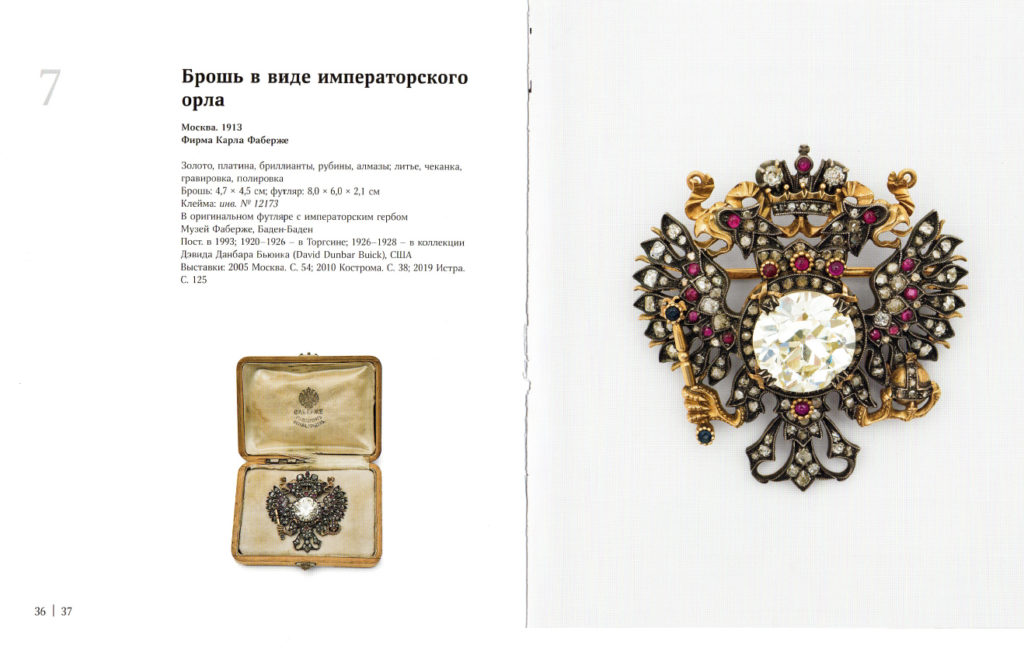
‘Fabergé – Jeweller to the Imperial Court’ The Hermitage Exhibition Catalogue
In subsequent articles published on my website I examined a number of Ivanov’s Hermitage fakes in some detail. I did not have the time or space to describe them all. Other forgeries in the show included a modern brooch in the form of a double-headed eagle (chosen, doubtless for patriotic reasons, to adorn the catalogue cover); modern hardstone figurines; two mass-produced silver folding/hinged eggs (cf Lot 261 in the upcoming Hargesheimer Russian Art sale in Düsseldorf on 16 April 2021 – estimate a measly €3,500), ‘improved’ by the addition of ridiculous Imperial gift inscriptions; strange jewellery with new fitted cases and falsified archival records; a locksmith’s vice with a bogus engraving to ‘prove’ it belonged to Fabergé workmaster Mikhail Perkhin; and various mundane copper items that Ivanov’s criminal cohorts had embellished with К Фаберже engraved hallmarks and dedicatory inscriptions borne of his fertile professorial imagination, claiming they dated from World War One and originated from Imperial ambulance trains and the hospital set up in the Winter Palace…
- Hargesheimer Kunstauktionen Düsseldorf Russian Art sale catalogue, 16 April 2021
- Hargesheimer Kunstauktionen Düsseldorf Russian Art sale catalogue, 16 April 2021
- ‘Fabergé – Jeweller to the Imperial Court’ The Hermitage Exhibition Catalogue
- ‘Fabergé – Jeweller to the Imperial Court’ The Hermitage Exhibition Catalogue
Ivanov has a soft spot for the Russian Imperial family. Quivering telepathic wires in his addled brain somehow sense Romanov treasures and lead him along a never-ending path of miraculous discovery.
More of the Ivanov-owned war matériel has been on display for years in the General Staff Building – an annex of the Hermitage Museum across Palace Square. The use of such precious space must surely have been approved by Ivanov’s titled accomplice Piotrovsky, even though no one had ever seen or heard about this garbage before.
Make no mistake: the corruption at the top of the Hermitage, and the putrid fall-out from the recent Fabergé exhibition, will haunt Russia’s most prestigious cultural institution for years to come.
EXHIBITION DATELINE
24 November 2020 Opening Ceremony
12 January 2021 Open Letter: Forgeries in the Hermitage
21 January 2021 First Conference
21 January 2021 Boris Piotrovsky named a Vice-Governor of St Petersburg
22 January 2021 (article 1) ‘Wedding Anniversary Egg’
14 February 2021 (article 2) Tearful Tiaras
24 February 2021 (article 3) The Good Soldier Ivanov
3 March 2021 Second Open Letter: Trying to Bluff His Way Out of It
4 March 2021 ‘Official Forgeries’ added to exhibition
4 March 2021 Second Conference
9 March 2021 Third Open Letter: My Beautiful Laundrette
14 March 2021 Exhibition Closes
18 March 2021 (article 4) St Nicholas Works Wonders
22 March 2021 (article 5) Lord of the Ring
A Catalogue of Errors – and Fakes
An exhibition billed as such a major event – the first Fabergé show in the Winter Palace since 1993! – should have warranted a weighty, authoritative catalogue: a work of reference for international academics and Fabergé connoisseurs for decades to come.
Instead, the Hermitage produced a small-format, 244-page paperback, as cheap as they come – and entirely in Russian, except for a one-page English Summary at the back, which boasts that the catalogue ‘gives its readers an insight into household beauty’ (as if Fabergé were some sort of interior designer, producing cute curtains and funky furniture for oligarch residences on Rublevskoye Chaussée).
The catalogue opens with a Piotrovsky preface and a short article by Tatiana Baboshina – cited as the catalogue’s ‘compiler.’ Then comes a History of the House of Fabergé by the late Marina Lopato who, even though she sadly died four months before the exhibition opened, is referred to as its Curator and ‘author of the concept.’ What concept? Is hauling ugly vitrines out of storage and stuffing them haphazardly with shameful stuff a ‘concept’? Baboshina must have done the installations; the design of the show was clearly never a consideration. Ivanov and his gang needed a catalogue and a show. Quality was irrelevant. They just needed to tick off that the Hermitage had hosted an important Fabergé show with stellar (ready to sell) material.
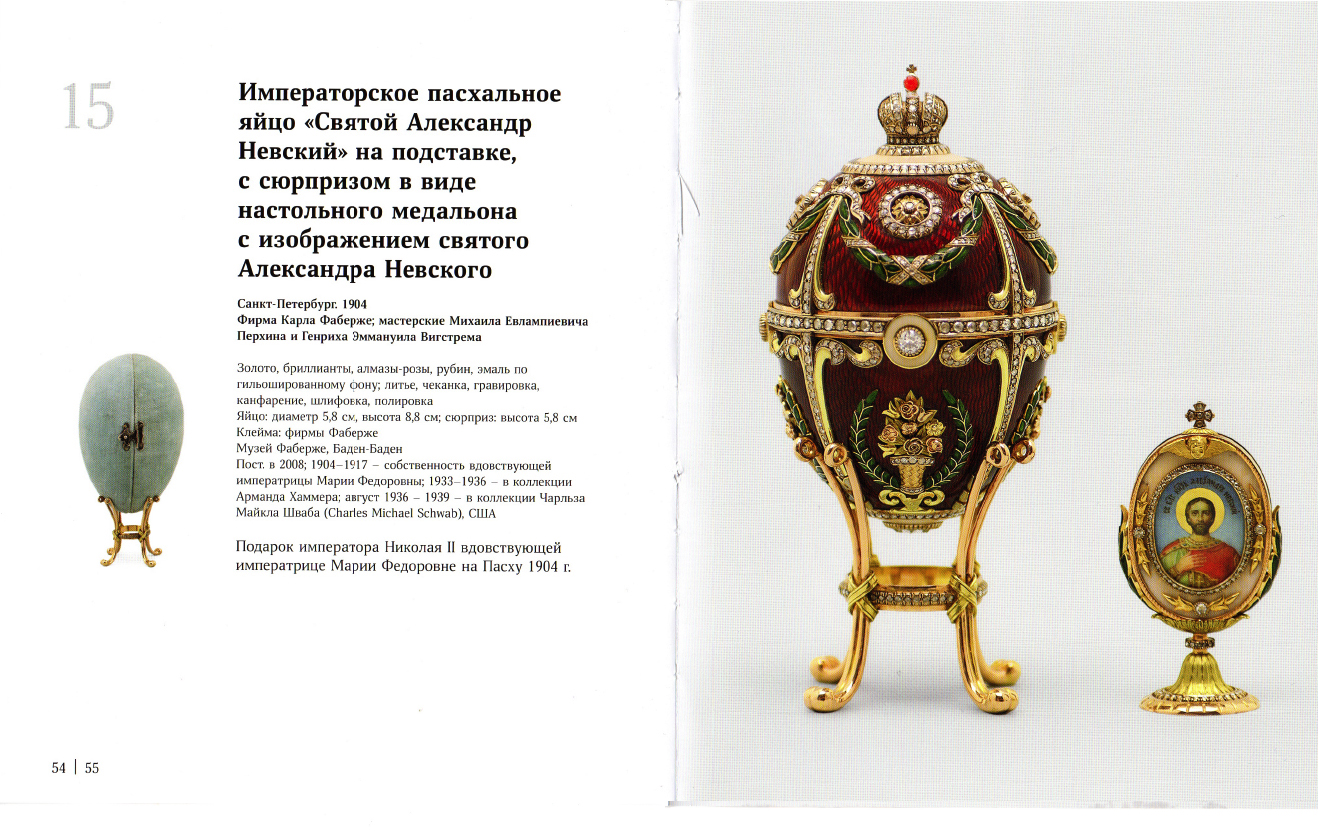
‘Fabergé – Jeweller to the Imperial Court’ The Hermitage Exhibition Catalogue
The catalogue’s descriptions of the 102 items in the show are cursory: just a few lines of elementary information, much of it false and deliberately misleading. Images are simplistic; none show hallmarks or details.
No fewer than 65 of the 91 ‘Fabergé’ items (over 70%) on display came from the three nefarious institutions with which the name of Professor Alexander Ivanov is indissolubly linked: the Fabergé Museum in Baden-Baden (46 items), the Russian National Museum in Moscow (11) and the Museum of Christian Culture in St Petersburg (8).
Just 26 items came from Russian State institutions: the Hermitage (17) and the former imperial palaces of Pavlovsk (5) and Peterhof (4).
Around 40% of the items exhibited were fake – many of them assigned a bogus Imperial provenance. All but one of these fakes were from the three institutions in which Prof. Ivanov is involved (the exception being a silver rooster purchased by or donated to the Hermitage in 1997, when Marina Lopato was in charge of the Fabergé Department).
Some of the catalogue’s provenance data raises concerns about Hermitage specialists’ level of historical training. I have not the slightest doubt that the information about the objects’ history was fabricated and supplied by their illiterate and devious owner – but it is unacceptable for the Hermitage to have blithely regurgitated such nonsense in its catalogue, effectively giving it a stamp of official approval. Did no one from the Hermitage raise an eyebrow at the notion of gifts to the Tsar from his daughters turning up in the unloved, abandoned Winter Palace years after the family had decamped to Tsarskoe Selo? Could no one from Tatiana Baboshina’s editorial team be bothered to check on when the well-known Soviet organization Torgsin was in operation, and establish that Prof. Ivanov’s web of deceit betrayed itself by recourse to impossible dates?
A study of the catalogue reveals that the more dubious the item, the more it was accompanied by complex, intricate and detailed information about its supposed origin. The hapless reader is asked to wade through a morass of preconceived bullshit and criminal error.
Professor Ivanov Speaks, and Speaks
Two months into the exhibition, on 21 January 2021, Professor Ivanov fronted a so-called ‘conference’ at the Hermitage to defend himself.
Well, it was dubbed a conference, but there was no ‘conferring’ – just a 90 minutes of gobbledygook. Ivanov ended his monologue with a couple of questions lobbed gently in his direction by sycophantic local journalists.
Ivanov treated me to a barrage of crude insults (‘crook’ and ‘thief’ being among the mildest). No surprise there. He also insulted the London dealers Wartski – by calling their recently rediscovered Third Imperial Easter Egg a fake. Even more shocking were Ivanov’s disparaging remarks about the leading Fabergé expert in Russia today: Tatiana Muntyan, curator at the Moscow Kremlin Museums.

Piotrovsky Will Defend His Accomplice Ivanov to the Death
It is fair to assume that the contents of Prof. Ivanov’s monologue were endorsed by Mr Piotrovsky. The monologue was delivered on Piotrovsky’s home turf, so to speak, and none of the vitriol that Prof. Ivanov unleashed has since been disavowed by the all-powerful museum boss. Piotrovsky has failed to disown Ivanov’s brazen insults of either Tatiana Muntyan or myself – or, indeed, to rebuke Ivanov for making them. Piotrovsky found my letter ‘aesthetically’ impossible to answer – yet a barrage of abuse from Prof. Ivanov did not cause the esteemed director the slightest concern. But what’s sauce for the goose is sauce for the gander….
Ivanov justified his fakes by brandishing some forged documents ‘discovered’ by the late Marina Lopato: a cowardly attempt to shield himself behind the name of a Hermitage researcher no longer able to speak for herself.
Marina Lopato died last Summer and has not been replaced. A little earlier the Hermitage had bade farewell to Alexander Solin, who was also involved in Fabergé research. There is no obligation for a museum to employ specialist experts in every field, but it is strange that such an important museum does not have anyone on its staff with specialist knowledge of one of the few Russian craftsmen whose name is glorified throughout the world.
Coincidentally, on the very same day that Mr Ivanov was delivering his Hermitage monologue, Mikhail Piotrovsky’s 38 year-old son Boris was appointed a Vice-Governor of St Petersburg – just four months after becoming Deputy Chairman of the city’s Culture Committee: an astonishing career-jump for someone with next to no managerial experience – and whose cultural credentials barely extend beyond designing the Hermitage website and being pals with the anarchic Russian rocker, Schnur. The rise of young Boris must reflect his personal charisma and intellectual sparkle. I’m sure we can discount thoughts of nepotism.
Chances are Boris won’t stay Vice-Governor for long. It’s rumoured in Russian cultural circles that, after reigning over the Hermitage for nearly thirty years, Mikhail Piotrovsky has groomed his son to further all his good work.
The Romanovs inhabited the Winter Palace for nearly 200 years. Will Tsar Boris cement the Piotrovsky Dynasty as their successors?
Alexander Ivanov: Facts & Figures
Alexander Ivanov declares himself an Expert for both UNESCO and the Russian Ministry of Culture. Works have been published in his name on the Russian Assay System and Pre-Columbian Gold (although everybody knows that Ivanov’s writings are penned by the medal-bespangled, self-proclaimed Christie’s ‘Research Consultant’ Valentin V. Skurlov).
Ivanov also lays claim to the title of ‘Professor.’ When questioned recently about his professorship by a BBC reporter, Ivanov was so taken aback he was unable to stammer a response. Sometimes the poor guy’s mind fails to keep track of all the lies it comes up with.
Whatever he is a Professor of, it isn’t Mathematics.
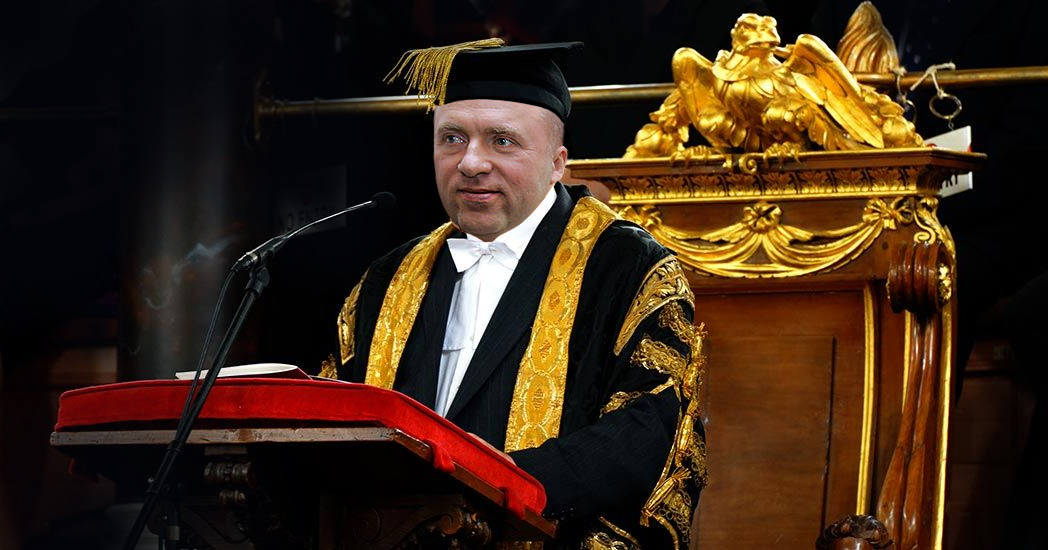
Fake Professor Lecturing from his Fake University
The Professor boasts of owning more Fabergé hardstone carved animals than the Queen of England: over 150 compared to Her Majesty’s measly 101. His own collection has been catalogued under the fetching title Fabergé Zoo.
Ivanov says his collection consists of thousands of items. Sometimes the figure is 4,000, sometimes it appears that those 4,000 items are in Russia, and Ivanov has another 3,000 stashed away elsewhere. Grand total: 7,000 – and growing! Ivanov says he buys 150-200 Fabergé pieces every year, and has done so for the past two decades. The only person who can possibly believe this (apart from Mrs Chicken-Farmer from rural Kentucky or Mr Crab-Collector in northern Kamchatka) is Ivanov himself. It is simply impossible to acquire 150 museum-quality Fabergé items every year (unless you do the Fabergé hallmarking yourself). You can buy ten or, at a pinch, fifteen bona fide quality Fabergé items a year (we’re not talking about spoons or forks) – if you’re lucky.
But Ivanov’s biggest lie is reserved for the supposed value of his massive collection: a stratospheric $2 billion. Viktor Vekselberg’s Fabergé collection, the biggest in the world (including nine Imperial eggs and seven other eggs), was bought for just over $100 million… twenty times less!
That $2 billion is what Ivanov claims an unnamed Sheikh offered him for his collection. Being a proud Russian patriot, oblivious to such untold riches, Ivanov nobly rejected this impudent attempt to have his Russian masterpieces borne away by camels across the desert sands.
$2 billion is a lot of lolly! Let’s put that figure in context.
Fabergé made around fifty Imperial Easter Eggs. Today two or three of them are in private hands. One is on the market for $30 million, though no one has jumped in at that price yet. Based on a simple calculation, all the Imperial Easter Eggs Fabergé ever produced should be worth a total $1.5 billion – maybe, if everyone’s feeling flush, $2 billion. And let’s remember that Prof. Ivanov does not (despite his claims) own a single genuine Fabergé Imperial Easter Egg: just modern fakes. Even if we imagined his fakes were actually real, their market value would still be no more than $120m.
So how on earth did the Professor’s enfeebled brain come up with a valuation of $2 billion for his collection ?
Piotrovsky Sells His Soul: The Lost Honour of the Hermitage and its Director
By supporting the shameful Fabergé exhibition, Mikhail Piotrovsky has not just humiliated the Hermitage but disgraced Russia. Everyone makes mistakes: what matters is how people react when such mistakes come to light. In this case we are probably dealing with deliberate policy.
I have only had the chance to attend a small number of exhibition openings in the Hermitage, as I have lived abroad for many years; but the few that I have attended personally, and those that I have seen on-line recently, did not feature such strange statements as those delivered by the Director before he took up his scissors and cut the ribbon to signal the exhibition was up and running.
If, as it appeared from his comments, Piotrovsky had doubts from the outset about the authenticity of some of the items on display, he should have exhibited them as ‘attributed to Fabergé’ or labelled with ‘owner’s attribution to the firm of Fabergé’ – though it would of course have been better not to have exhibited such ‘masterpieces’ at all.
I have written three Open Letters to Mr Piotrovsky – and five articles examining the exhibition’s most glaring fakes: the ‘1904 Wedding Anniversary Egg’, four diamond tiaras, a Soldier figurine, an enamel icon oklad, and a gold ring supposedly given to Nicholas II by his daughters.
My first Open Letter questioned the competence of Hermitage personnel. As there is no longer any Fabergé expert on the museum’s books, why not call in an outside expert when the situation warrants? That’s what the Victoria & Albert Museum has done (with Wartski’s Managing Director Kieran McCarthy) to prepare their forthcoming Fabergé show
Piotrovsky disregarded my letter. His Excellency did not like its style, never mind its substance! Even though a number of items on display had – as I subsequently demonstrated – been recently purchased at Sotheby’s or Christie’s, neither of whom had spotted any connection with the House of Fabergé or the Russian Imperial Family whatsoever, Piotrovsky continued to lend Ivanov his unequivocal support. That means either that someone had paid Piotrovsky (who, after all, is 76 and presumably wants to savour a well-heeled retirement) to display Ivanov’s fakes; or that somebody powerful, important, and in cahoots with Ivanov, interested solely in money and totally oblivious to Russian culture or the Hermitage’s prestige, had approached Piotrovsky and either scared him into submission, asked him to return a favour, or invited him to join the team and become a partner.

Piotrovsky’s Hermitage Kiosk of “Treasures” – Fresh Juice, Faberge Eggs, Chewing Gum, M&M’s, Hamburgers
The criminal goal of Professor Ivanov (and the others involved) is clear and obvious: legitimizing a huge series of fake artefacts so that his collection’s value soars after being exhibited in the Hermitage, with its authenticity difficult to question. Potential buyers include the Hermitage itself.
Although Ivanov’s conduct warrants legal scrutiny is not, in itself, all that unusual. The strange actions of the Director of one of the world’s largest museums, however, endanger not only his own considerable authority, but also the reputation of the institution over whose destiny he presides – a reputation earned by thousands of hard-working specialists over a period of 250 years. The scandal at the Hermitage also casts a shadow over other Russian museums.
Let me explain just why I pay so much attention to the behaviour to this Mr Piotrovsky.
It is bitterly disappointing that the Director of the State Hermitage has behaved – in a situation he apparently anticipated – in a dishonest and anti-cultural fashion.
And it is strange that, having received information about the quality (or lack of quality) of a number of items on display, Mikhail Piotrovsky responded not by studying the information but by denying the importance of preparatory work – and giving the floor to the owner of all this dodgy caboodle to utter insults and threats against me.
The initial response to my first Open Letter was a stream of insults fed to sycophantic journalists by the proud museum Director. He subsequently chose as his strategy to hush up the problem. It was only when a BBC investigation blew the lid on the story that Mikhail Piotrovsky pretended to carry out ‘research’ on exhibits, explaining blandly that ‘any exhibition in the Hermitage is a research project. The technical analysis of the objects on display is part of the research program of the Faberge Hermitage.’
Contrast that approach with how London’s Victoria & Albert are preparing for their own Fabergé show to be held later this year. This will be a blockbuster affair with over 300 exhibits – including the original Hen egg from the Fabergé Museum in St Petersburg (not some cheap pastiche as shown in the Hermitage) and the recently rediscovered ‘Third Imperial Egg’ (which Professor Ivanov jealously dismissed as a fake in one of his Hermitage lectures).
All the V & A’s exhibits will hail from well-known collections and be scrutinized in advance of the show – not during it, whatever the wise example of Mikhail Piotrovsky.
- Fake figurine in exhibition catalogue for Fabergé – Jeweller to the Imperial Court, State Hermitage Publishing House 2020
- Fabergé Soldier figurine – Fersman Mineralogical Museum, Moscow
Like the Hermitage, the V & A will be showing a Fabergé Soldier figurine: but this time it will be the original and authentic one from Moscow’s Fersman Mineralogical Museum – not an artful Ivanov imitation. Neither the V & A nor the show’s curator, Kieran McCarthy, have asked to borrow any items from the Ivanov Collection. How strange!
The ‘research’ that Hermitage Director Mikhail Piotrovsky talked about was assigned to in-house specialists, i.e. his administrative subordinates. That hardly inspired confidence, given that the august Director had already deemed the items worthy of being exhibited. After extending a platform to Professor Ivanov to expound on how Imperial Easter eggs were subject to endless ‘replicas,’ the tendentious research report confirmed my worst suspicions that the Director is involved in a cover-up… ending up as an accomplice of the fraudster Ivanov.
Under the leadership of its esteemed Director, the Hermitage seems to have reached the point where it has no specialists left capable of preventing such a catastrophe as this sad and sorry Fabergé exhibition. When I offered specialist opinion, seeking to protect the reputation of Russia’s leading museum, I received no thanks – only insults, and contempt for my status as a dealer.
Instead of learning from all those who go to the trouble of sharing serious professional information, Mikhail Piotrovsky divides specialists between the ‘bluebloods’ who work for his Museum and everyone else… talking to whom is below his dignity. It is no surprise that this childish attitude to knowledge has led the Hermitage into an abyss of shame.
Mikhail Piotrovsky is an accomplice in a crime against the Russian people. Instead of ensuring that the Hermitage fulfils its rôle to educate the public, he has pursued selfish goals of his own, disgracing the Hermitage in the process.
What is the true nature of the relationship between the intellectual academic (Mikhail Piotrovsky) and an ignorant pseudo-professor (Alexander Ivanov) – apart from business and money? In other words, corruption.
What about the moral obligation for Mikhail Piotrovsky and his museum staff to work honestly and resist outside temptation? Is he driven by a desire for loot, consumer goods, social standing, a place at the top table, a chauffeur-driven BMW (latest model)… and the prospect of transferring power at the Hermitage to his offspring?
Kommersant, The Art Newspaper Russia and other journals – ‘partners’ with the Hermitage, as they like to call themselves – strive to convey the impression that Piotrovsky and his henchmen, minions and accomplices can do nothing wrong. The Art Newspaper Russia did not even produce an article on the Hermitage scandal… and its supposedly ‘authoritative’ English-language sister-paper only dribbled out some mealy-mouthed coverage weeks after the international press had got their teeth into the story. Just what exactly does a Hermitage ‘media partnership’ involve, pray? Subjecting H.R.H. Mikhail Piotrovsky to endless bum-licking, and throwing objective journalism out of the window?
Let me quote the words of the renowned Fabergé authority Geza von Habsburg, known for his work at Christie’s, for coining the term Fauxbergé, and for curating specialist exhibitions (including Fabergé In America at the Metropolitan Museum in New York):
‘What Ruzhnikov wrote, in my opinion and in the opinion of a number of my colleagues, is correct. It is unusual for a museum to display items that have neither provenance nor scientific research to prove their authenticity.’
Pardon Pardon, Baden-Baden?
Professor Ivanov owns two museums. One, patriotically, is in Moscow. It is modestly entitled the Russian National Museum and was founded in 1993. Its current domicile is 29 Ulitsa Nizhnie Polya: a grimy concrete block built in the 1960s in Moscow’s southern suburbs. Good luck trying to visit what some call the Russian National Ghost Museum.

Russian National Museum Headquarters in Moscow
At some point in the past, the Russian National Museum had another address: 2/6 Pushechnaya Ulitsa in the centre of Moscow, just a stone’s throw from the KGB’s Lubyanka headquarters. A bit of Googling reveals that, sure enough, there was a Russian National Museum at such address – but snapshots available online reveal that it was never a museum… just a modest antiques centre, where all the priceless museum exhibits were adorned with price tags. The naïve Mikhail Piotrovsky was no doubt unaware that, despite its pompous name, the Russian National Museum is a paper tiger: back in 1993, when it was founded, the Museum’s start-up capital was declared as 1,100 rubles (about 12 euros at today’s exchange-rate).
- Russian National Museum Antique Centre (sticker on the door), 2/6 Pushechnaya Street, Moscow, 2017
- Russian National Museum, 2/6 Pushechnaya Street – doors locked, no sign of life in the “museum”, Moscow, 2021
The Professor’s second outfit, modestly entitled the Fabergé Museum, opened next to a Thai massage parlour in the spa town of Baden-Baden (south-west Germany) in 2009. No fewer than 46 of the 91 ‘Fabergé’ items (i.e. over half) displayed in the Hermitage show came from this venerable institution.
His throat forever warmed by a long, monochrome scarf, the smooth-talking Mikhail Piotrovsky – Russia’s very own Artful Dodger – may have given his professorial accomplice the Hermitage as a platform to strut his stuff untroubled by legal interference, but I very much doubt that Ivanov will find the same friendly shelter in Baden-Baden – now that it has emerged that he has been flooding the law-abiding little town with Fabergé fakes while charging 18 euros for the privilege of gawping at them. No other museum in the world has the audacity to match Ivanov’s entry-price greed.
Ivanov reports that 700-800 items from his Fabergé holdings are on show at his German lair. In 2014, the usually respected Russian newspaper Vedomosti published an article about the so-called Baden-Baden Fabergé Museum and its dynamic director. It was headlined A Russian Collector Has Gathered One of the World’s Largest Fabergé Collections and it was based on a friendly interview with Prof. Ivanov conducted by the gullible Elena Tuyeva. The only opinion expressed in the article was Ivanov’s, the Professor of unknown studies and sciences. Tuyeva, a professional journalist from Vedomosti, must have been so enamoured by Professor’s innate eloquence, intellect and harsh provincial accent that she saw no reason to challenge his statements or seek the opinion of others in the antiques trade or museum world. Journalism is reputedly the world’s second-oldest profession. Tuyeva’s approach suggests she confuses her trade with an even older one.
She coaxed some fabulous stuff out of Ivanov. He revealed to her that, when he sought to rent premises to display his ‘collection’ in the mid-1990s, it would have cost him $50m to do so in Moscow (for $50 million he could have built – not rented – a whole street!).

The Fabergé Museum, Baden-Baden
The Fabergé Museum finally opened on Baden-Baden’s Sophienstrasse in 2009 in a sturdy (but hardly glamorous) town-house formerly owned by a tobacco company, and built around 1900, with some 800m2 of floor-space. The building was in good condition and needed little renovation. Yet Ivanov told Vedomosti he had spent €17m on setting up his museum (with only 350m2 of its 800m2 allocated to exhibition space). What on earth can he have spent it all on, pray?
In California today, for example, you can build – from scratch! – a new building of 800m2 for $8 million (about $10,000 per m2).
Was Ivanov joking when he talked about splashing out €17 million? Or just proferring another outrageous lie?
Whatever it was, Tuyeva swallowed it.
There is, however, a very good joke in his Baden-Baden museum: a composition made from semi-precious stones known as Proletarian Breakfast. It looks like a 3-D version of a painting from the Russian Avant-Garde and features a herring, a fried egg and a glass of vodka placed on a brick; the brick is made of jasper, the herring from silver and the egg from amber and opal. Ivanov reportedly paid $1.1m for it in 2011, believing it to be a bona fide Fabergé.
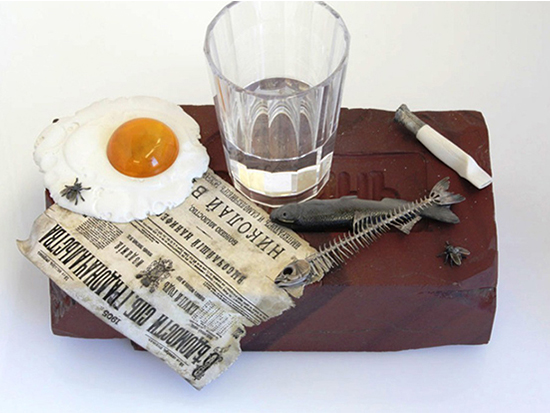
‘Proletarian Breakfast’ (Fabergé Museum, Baden-Baden)
In fact, Proletarian Breakfast was made in 2005 by the late St Petersburg stone-cutter Yuri Toptunov – as revealed on the Sisyphus website by his younger colleague Alexander Solomonovich Leventhal in 2008, a year after Toptunov’s death.
Even if we assume that Ivanov does not know how to read, and had never heard about the prankster Petersburg stone-cutter, he should have realized the item is a spoof. Craftsmanship for Carl Fabergé was a serious business. He never indulged in three-dimensional jokes.
The joke, in fact, is on Professor Ivanov – who likes to commission hardstone compositions himself. Producing such complex objects is a thankless task, requiring a good designer and excellent craftsmen. Luckily, Prof. Ivanov has charmed his way into the good graces of a man capable of producing animal figurines so skilful they can be passed off as Fabergé.
He owns a stone-cutting workshop in St Petersburg. His workshop has successfully supplied Ivanov with dozens of carved elephants and other wonderful beasts – not to mention a Tsarevich Egg. His name is Alexander Solomonovich Leventhal.

Alexander Solomonovich Leventhal
As we know, Professor Pavel Plechov – head of the Fersman Mineralogical Museum in Moscow – wrote to inform Mikhail Piotrovsky that Ivanov had been given access to several of the Fersman’s exhibits (e.g. the ice carrier, fag-lighting soldier and unfinished Imperial Constellation Egg). According to Professor Plechov, copies of the Fersman’s pieces started appearing on the market soon after Ivanov’s visit. Piotrovsky – busy exhibiting Ivanov’s forgeries in the Hermitage – disregarded his colleague’s letter; a curt ‘thanks for the info’ was received by return mail.
So much for our stalwart supporter of our history and culture.

